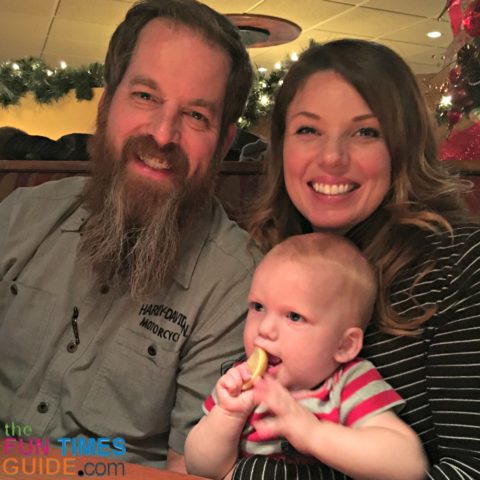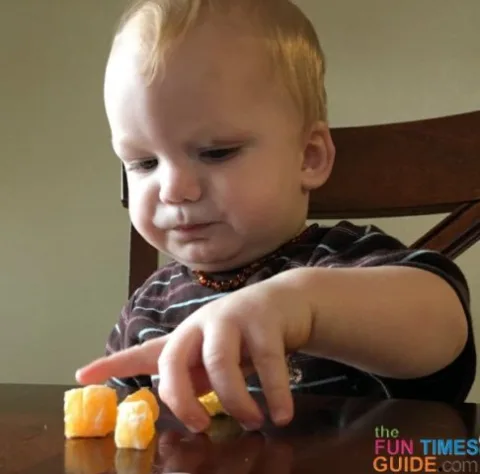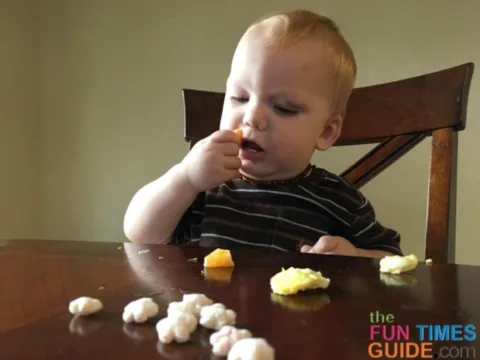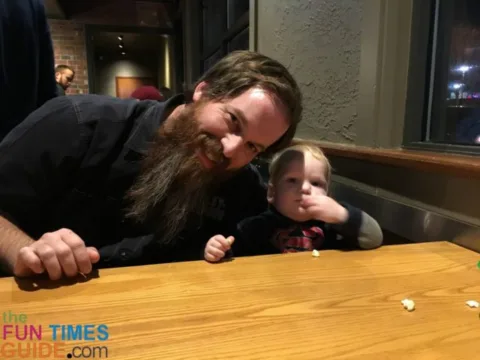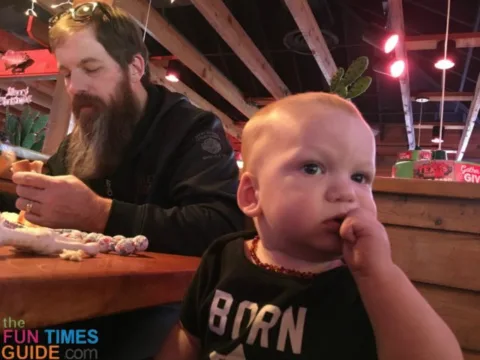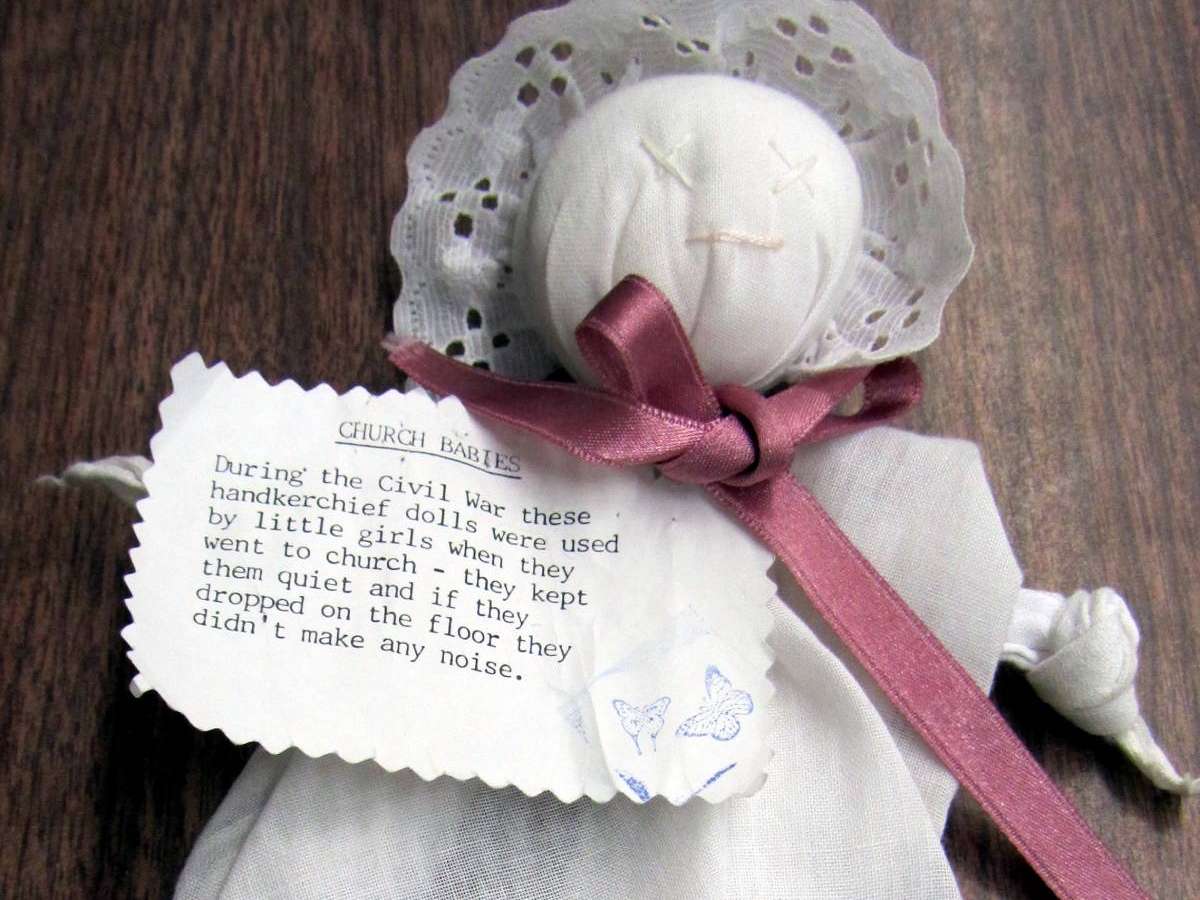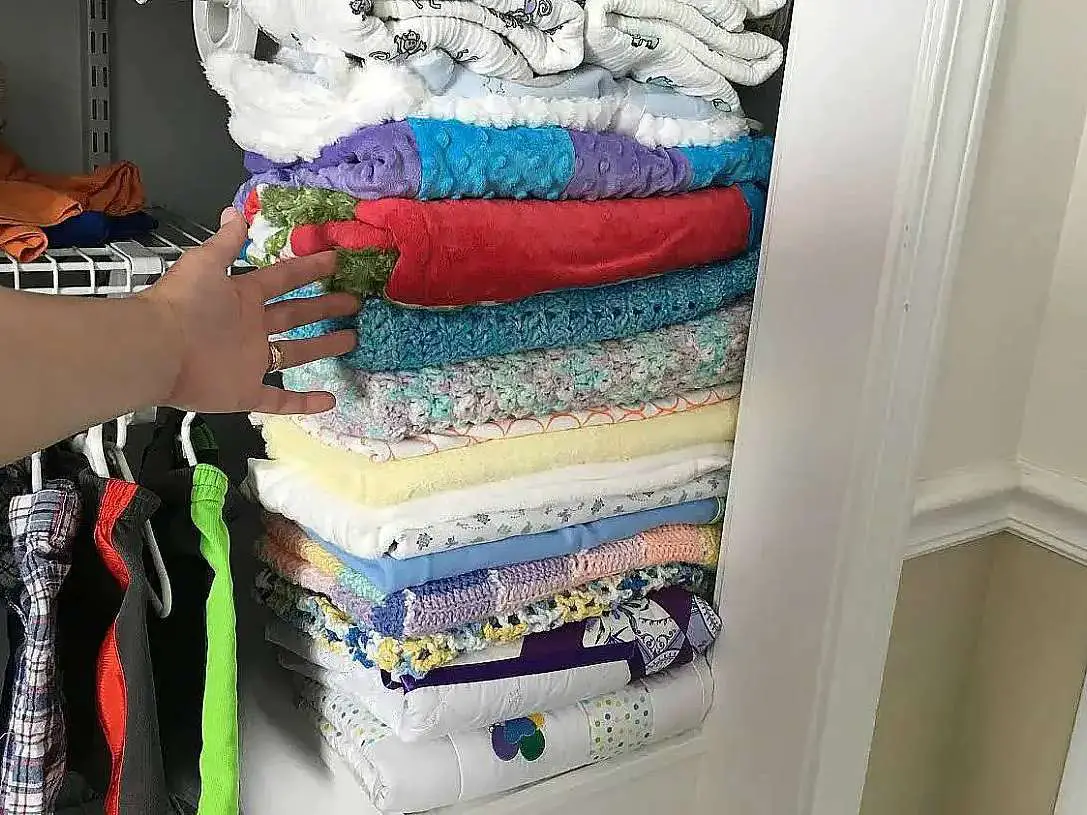I had plans to make my own baby food once I started introducing solid foods to my exclusively breastfed baby.
Lucky for me and moms everywhere, I discovered a better way when it comes to family meal time with baby.
It’s called baby led weaning (also known as BLW):
- The basic theory is to start introducing complementary foods to your baby’s diet, in addition to the breast milk or formula.
- With baby led weaning, the baby self feeds — imitating the family members in the dining experience. This allows mom, dad, and/or caregiver to enjoy their own meal at the same time as baby.
Baby led weaning is a phrase that was first coined by Gill Rapley and Tracey Murkett in their book Baby-Led Weaning: The Essential Guide to Introducing Solid Foods.
We started BLW when my baby was approximately 8 months of age.
What Baby Led Weaning Is Like
Besides the mess of it, we quite enjoy meal time as a family.
Our family meal time looks something like this:
- My husband, baby & I sit down to eat at home or a restaurant (we like to dine out frequently).
- Baby is seated and strapped into his Bumbo seat at home or in high chair at a restaurant.
- Baby feeds himself with whatever food is placed in front of him within his reach.
- My husband and I enjoy our dinner and conversation — while baby observes and interjects his own cute babbling to the conversation.
I started the baby led weaning process with my baby offering one food at a time within a 24-hour window, as recommended by our pediatrician. That way, we could watch for any allergic reactions to specific foods.
Here’s a list of baby led weaning foods to start with.
His first food was steamed and cut up carrot. He was allowed to grab the pieces and experience real food in his mouth for the first time.
Then I introduced cucumber, orange, and any other soft fruit or vegetable which could be cut up in baby-grasping size for self feeding.
Here’s another list of 12 finger foods for babies that don’t come from a box.
Surprisingly, babies catch on rather quickly to this whole eating concept.
I was never in a hurry to have him eating solid food — so I really just let my baby learn at his own pace.
I simply started putting food in front of him, allowing him to grab the food and put it in his mouth.
At first he would gag and make faces. But eventually he began to chew and swallow after feeding it to himself.
Reasons To Try Baby Led Weaning
Here are some of the benefits of baby led weaning:
- Baby self feeds, giving caregivers time to enjoy their meal as a family.
- Baby explores different foods — tastes, colors and textures — on their own. This generally leads them to eat a wide variety of food, almost anything and everything.
- Baby joins in on family meal time and thinks of it as a fun activity.
- Helps baby refine their motor skills — picking up food, putting it to mouth, hand-eye coordination, etc.
- Parents don’t have to specially prepare purées or other baby food. Instead, you can cut up what is being served into “baby grasping” bite-size pieces.
- Baby learns self-regulation and will stop eating when he feels full.
See another mom’s list of baby led weaning pros and cons.
Babies who self-feed cannot realistically be made to eat more than they need since they are feeding independently,” says Natalia Stasenko, a pediatric dietitian and co-writer of Real Baby Food. “With spoon-feeding, parents can sneak in a couple more spoonfuls even if the baby is full. Doing so frequently will teach the baby to routinely eat more than he needs and stop regulating his intake efficiently.” Source
Before You Start Baby Led Weaning…
Honestly, I was a bit apprehensive at first regarding baby led weaning.
As a new mom, I was worried about my baby choking. But now that we’ve been at it for about 3 months, I can’t imagine introducing solid foods any other way.
Ready to give baby led weaning a try? Here are some tips for success:
- Make sure your baby can sit upright unsupported. Your baby should also have good neck strength and show signs of readiness to eat solid foods.
- Start slowly with soft food, introducing only 1 food at a time. Then, wait 24 hours to introduce another new food — so you’ll be able to pinpoint any allergic reactions, if they should arise.
- Prep foods for baby into easy-to-grasp pieces. Eventually you can cut up what is on your plate.
- Prepare for things to get messy! This includes your baby’s hands, face, clothes, your floor, etc. (We have dogs — so they help with the floor clean-up quite a bit!)

- Continue with breast milk or formula. Baby is still going to get the bulk of their nutrition from these for the first 2 years. I plan to breastfeed for at least 2 years.
- Always dine together and allow baby to watch, observe, and interact. This way, baby learns behavior from the family and you can continue to supervise your baby’s eating.
- Be patient and allow your baby to learn at his own pace. Timing is key too. Try to time family dining when your baby is not overtired.
- Keep baby-friendly snacks handy. We always keep cereal puffs and fruit pouches on hand — our baby loves them! They make for a quick snack while you’re cutting up some food for baby. (We keep the cereal puffs in these non-spill snack cups — so baby can reach in, grab some puffs, and self feed without spilling.)
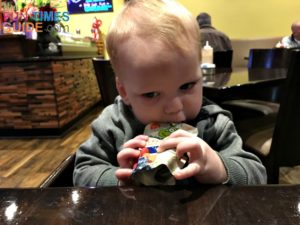

- Baby will gag at first — this is completely normal. Babies have a natural gag reflex if something unfamiliar touches the back of their tongue — which causes them to thrust their tongue forward. Eventually the gag reflex subsides, as your baby continues to eat and experience new foods. It’s important to remain calm, let the process happen, and observe mindfully. Avoid foods which can easily be choked on — such as nuts, grapes, raisins, seeds, hotdog slices, popcorn, etc.
- Quit feeding baby if food is getting tossed. This is a good indication that baby has had enough.
- Don’t give up. If spoon feeding is what you’re comfortable with, you should continue with that and then slowly incorporate some of these baby led weaning tips over time.
- Always be prepared. As an extra safety precaution, I downloaded the FREE American Red Cross First Aid app. The app is full of useful information — with pictures and videos on what to do in an emergency (including infant choking). It is one of those resources and/or skills that I would just rather have in my mommy arsenal in a life-threatening situation.
The Bottom Line
We love eating together as a family — especially when we’re dining out in restaurants.
We always get compliments on how well-behaved our baby is when we are eating together in restaurants.
Watching our baby self feed himself is part of our entertainment. It has been such a joy to watch the whole process as he learns new skills and discovers all the different tastes and textures.
Baby led weaning is not a race — so I don’t ever compare my baby’s development or eating skills with other babies. I just enjoy each moment on this incredible journey of discovery together!

